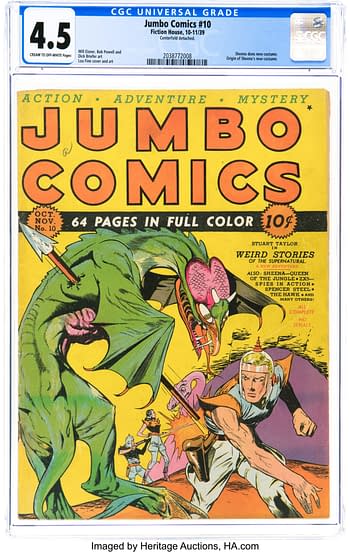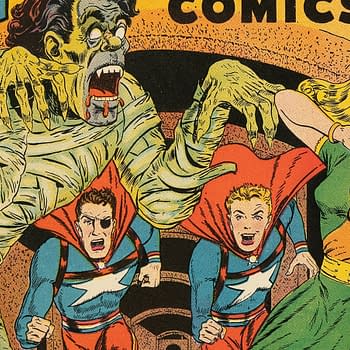Posted in: Comics, Heritage Sponsored, Vintage Paper | Tagged: fiction house, golden age, pulps, spicy history stories
Man Who Vowed to Kill the Kill-Joys: Fiction House's John W. Glenister
The Fiction House story can't be told without distribution pioneer, anti-Prohibition activist, and champion swimmer John W. Glenister.
Fiction House founder John W. Glenister was a man who embodied the notion of living life to the fullest. During a 1922 trip to the UK, he was filmed for a newsreel short titled Man Who Vows to Kill the 'Kill-Joys' in which he forcefully went off against the side effects of what he termed "crime-breeding prohibition", which had been enacted in the United States two years prior. "Fanatics in America are manufacturing Bolshevism, smuggling, and druggism wholesale," Glenister declared. "The working man's beer has gone! And they are trying to stop his tobacco! Now they want to kill the movies –and every other joy."
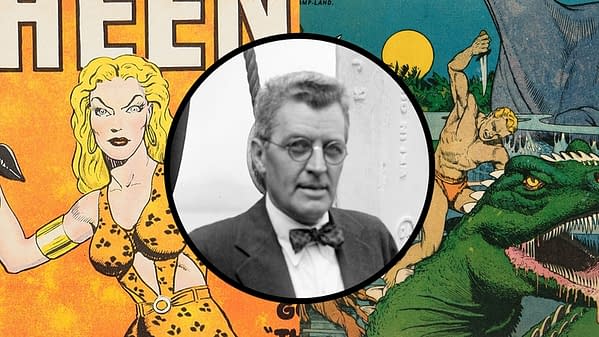
Glenister would become a noteworthy anti-Prohibition activist during this period, while also taking seriously the threat of film industry censorship that was developing at this time as well. And this was after he had become a major force in the development of the Independent Distribution system in the United States, a respected magazine executive, and a nationally famous athlete. While John W. Glenister died at the age of 63 on October 14, 1937 — less than a year before the fiction magazine publishing company he founded with John B. Kelly entered the comic book business — his larger-than-life sensibilities would remain thoroughly embedded in Fiction House for that company's lifespan. The Fiction House story can't be told without discussing the early career of John W. Glenister. Heritage Auctions recently opened a new Fiction House Showcase Auction, and we'll be taking a deep dive into the comics of Fiction House and the people who made them over the next few weeks until the auction closes on October 19.
Born January 11, 1874, in New York City, John W. Glenister emerged as a public figure in America long before becoming an outspoken publishing industry executive. In the late 1890s, he began to take part in swimming exhibitions and competitions in the Northeastern U.S. that garnered him media recognition. In 1899 came an early glimpse at his entrepreneurial leanings, as he lent his increasingly famous name towards setting up an exhibition for another swimmer in Rhode Island. He then turned briefly to vaudeville in 1899-1900, seemingly with little success. He sought financial backers for a play in Chicago, and apparently also attempted to use his name to form a vaudeville talent agency there, before returning to New York City in October 1900 to be part of the warm-up act for the play Reaping the Whirlwind.
With his vaudeville career gaining little traction, Glenister soon returned to swimming exhibitions with an exceedingly dangerous stunt which he used to increase his profile. On August 18, 1903, he became the only man to ever swim the whirlpool rapids below Niagara Falls. This incredibly treacherous feat had claimed the life of another man in a previous attempt, Captain Matthew Webb, in 1883. When Glenister was asked about his reasons for risking his life at Niagara Falls, his answer was simple and direct, "You ask why I do this? I will be truthful. I will do it for money. I expect to go on the stage and on exhibition, telling of my experiences while going through the rapids."
The Niagara Falls stunt seems to have garnered Glenister the notoriety that he wanted. Within a year, he was at the center of an enormous celebrity endorsement campaign for a "healthful" spring tonic. Bernarr MacFadden's pioneering health and fitness magazine Physical Culture named Glenister as being in the running for the top prize in their Great Physical Culture Exhibition competition being put on to find "the most perfectly developed man and the most perfectly developed woman" that year. In 1905, Glenister was even name-checked by that other pillar of sporting notoriety, the Police Gazette, for challenging a rival swimmer to a competition.
Glenister's swimming exploits and the Niagara Falls whirlpool rapids swim in particular would indeed be a memorable part of his bio blurb whenever he was written about (which was often) for the rest of his life, but it would be another development around this time that would carry him through to the next stage of his career. As pointed out in several accounts of the Niagara Falls event, Glenister was also a newspaper writer at the New York Telegraph at that time and would work for a number of newspapers in various capacities over the subsequent few years.
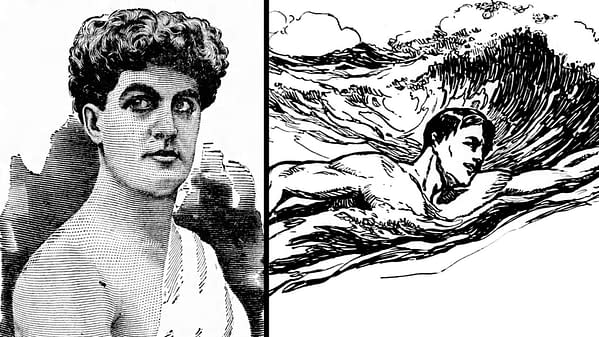
By 1908, John W. Glenister had moved onto the magazine field, penning what is in sports circles considered a historically important article for Baseball Magazine Volume 1 #2 that year titled Who Wrote Casey at the Bat? That year was the 20th anniversary of the initial publication of Casey at the Bat, and some controversy had arisen regarding the authorship of that legendary poem. Glenister's article is referenced in books on the subject of the poem to this day, and the actual author of Casey at the Bat, Ernest Lawrence Thayer, told Glenister, "Some years ago the supporters of a man named Valentine had a long and very circumstantial account about when and where he wrote the verses, in a Los Angeles paper. Valentine was dead at the time, but the story of his career interested me so much that I employed a Pinkerton detective to look at the matter. It is simply impossible to stop this kind of thievery, but I would cheerfully give up a little money for the pleasure of scorching one of the thieves. I started on the trail of two other claimants, only to find that they had found refuge in the grave. If I can get hold of a live one, who is a person of any consideration, I should like to make the beggar ashamed of himself."
But it was his move to Good Housekeeping Magazine later that year that was to put his name on the map in publishing and distribution circles. Glenister quickly made noteworthy moves as circulation manager of the publication, and by the end of 1909, industry trade journal Editor and Publisher noted, "Three stars are twinkling merrily somewhere in the West. They are John W. Glenister, circulation manager of Good Housekeeping Magazine; J.B. Kelly of American Magazine, and Tom Martin, circulation manager of McClure's Magazine. They are all busy for their respective publications."
Of course, J.B. Kelly of American Magazine would be John B. Kelly, the man who would become Glenister's editor and partner at Fiction House some twelve years later. In the meantime, after stints at Good Housekeeping Magazine, Pictorial Review, and Every Week, Glenister had become such a magazine industry circulation star that when he joined E.F. Warner's The Warner Publications in 1916 (no relation to Warner Bros), the company took out a full page ad in industry trade magazine Printer's Ink touting his arrival. The company was the publisher of magazines including The Smart Set, Saucy Stories, and The Parisienne.
Warner Publications wasted no time in making dramatic changes to its distribution practices under Glenister's guidance. According to Fourth Estate: A Weekly Newspaper for Publishers, in early 1918, "The Warner Company has made all its publications non-returnable through the American News Company, its former exclusive distributor, and is now supplying 600 wholesale dealers and 2000 retailers direct. This new system of distribution requires a much larger force, and it will be under the personal direction of Mr. Glenister, who for the past year has been the circulation manager."
While the non-returnable aspect of this move was temporarily triggered by inefficiency in the changing American distribution landscape, this "new system of distribution" would be a prelude to Glenister's role in helping shape the future of newsstand distribution in the United States. According to an S-M New Company internal history, to address shortcomings of the Independent Distribution system outside the American News Company monolith, "In May 1919, John W. Glenister of Warner Publications, Guy Harrington of Brewster Publications, and Bert Mackinnon of Pictorial Review arranged a meeting of all prominent independent distributors and all independent publishers. This meeting was held at the Hotel Pennsylvania in New York. Almost 300 wholesalers as well as the publishers' executives and representatives attended. Definite recommendations for the improvement of the structure of the industry were made by the then "shining lights" in Independent Distribution. This meeting was extremely important, because it marked the beginning of the close cooperation within the industry that is so evident today."
The structure, standards, and cooperation among the companies of the periodical publishing, distribution, and newsstand industries that Glenister helped to spark in early meetings such as this from 1919-1921 would encourage the subsequent development of Independent Distribution companies like Eastern Distribution Corporation and Kable News Company. Such independent distributors would prove important to the pulp and comics industry and the people involved. Glenister himself helped establish the British News Company which had a focus on publishing British editions of U.S. publications, and in 1921 launched The Glenister Service, an apparently short-lived distribution-related company about which little is known.
Finally, on April 15, 1921, Glenister incorporated Fiction House along with two other men, E. Adams and Maxwell L. Crames. Crames was an attorney and a financier in a wide variety of industries and associated with the law firm Lind & Pfeiffer, which later became Lind, Pfeiffer & Crames. It appears that Crames was involved in the founding and financing of companies in a range of business categories such as heavy manufacturing, building materials, movie theaters, and fashion in the early 1920s.
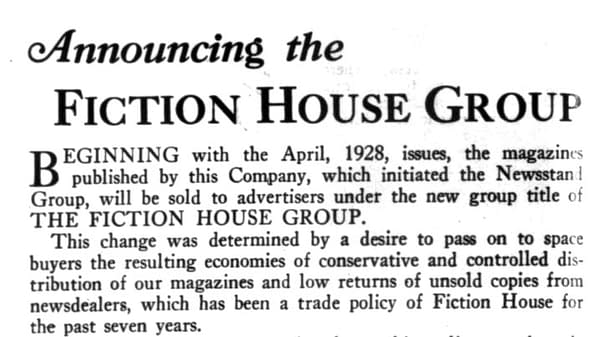
While John B. Kelly's name is notably absent from that original incorporation, he was out in front as editor of the company when Fiction House announced the launch of their first publication, Action Stories, which had targetted an August 1, 1921 release. While various readings of the Fiction House history have Glenister retiring somewhere between 1927 and 1930, it is likely that he had more of a big-picture focus from the beginning, leaving much of the day-to-day operations of the company to Kelly. Weeks after incorporating the company and with its debut publication set to launch four months later, Glenister was involved in an effort to defend the film industry against censorship in New York state, as the Lusk-Clayton Motion Picture Censorship Bill would establish the New York State Department of Motion Picture Censorship that year, and other states were attempting to enact similar laws. With his fledgling publishing company just months old in early 1922, he would spend five months in the UK, weighing in on the issue of Prohibition while also advising Sidney Cohen, president of the Motion Picture Theater Owners of America in the continued fight against state-level film censorship issues. Based on public notices he spent considerable effort organizing and publicizing "The People's Voice League" against Prohibition throughout the rest of 1922 and into early 1923.
John F. Byrne was elevated from the staff to managing editor of Fiction House in 1929. Byrne would ultimately play a key role in the publisher's comics era beginning a decade later. Glenister's son-in-law, Thurman T. Scott, began to be listed in Fiction House publications as corporate secretary in 1932 and spoke on behalf of the company around the time of John B. Kelly's death that year. Glenister himself would pass in 1937.
While Thurman T. Scott among others would usher Fiction House into the comic book era beginning with Jumbo Comics in 1938, it's clear that John W. Glenister's life and background set the trajectory for the publishing company he founded from the beginning. Examples of the comic book legacy of the company that Glenister founded are up for auction in the 2023 October 19 The Fiction House Comics & Comic Art Showcase Auction #40235 at Heritage Auctions. New to collecting Fiction House or want to learn more? Bleeding Cool is doing an ongoing deep dive into the history behind Fiction House in the run-up to this auction. If you've never bid at Heritage Auctions before, you can get further information, you can check out their FAQ on the bidding process and related matters.
- Jumbo Comics #10 (Fiction House, 1939)
- Jumbo Comics #31 (Fiction House, 1941)



